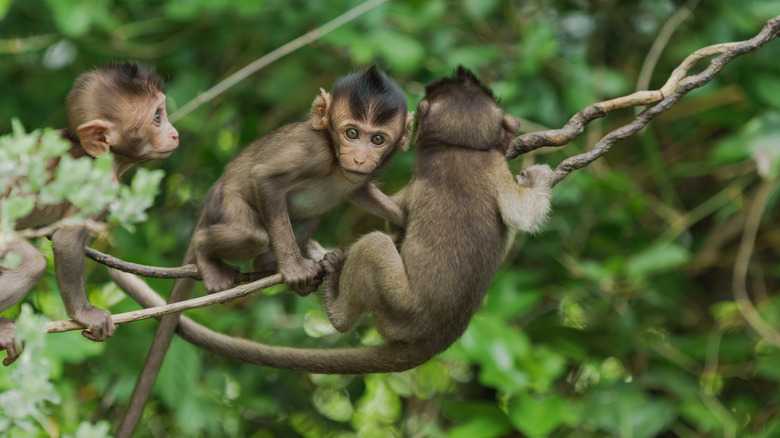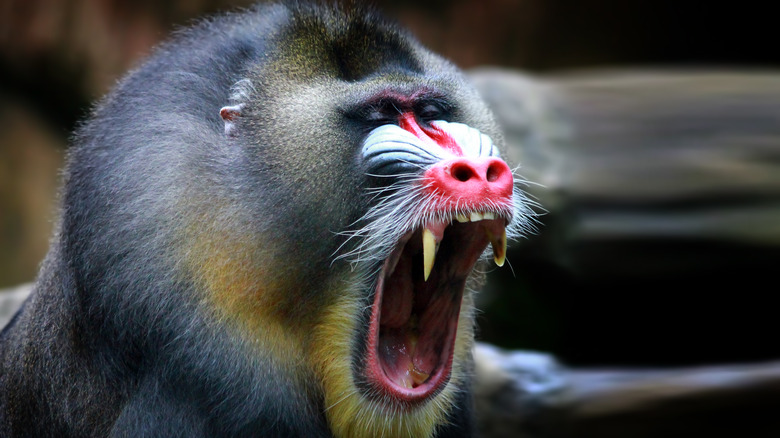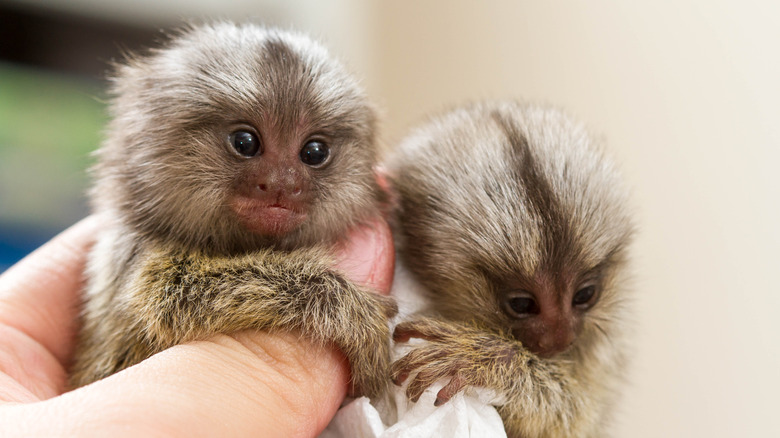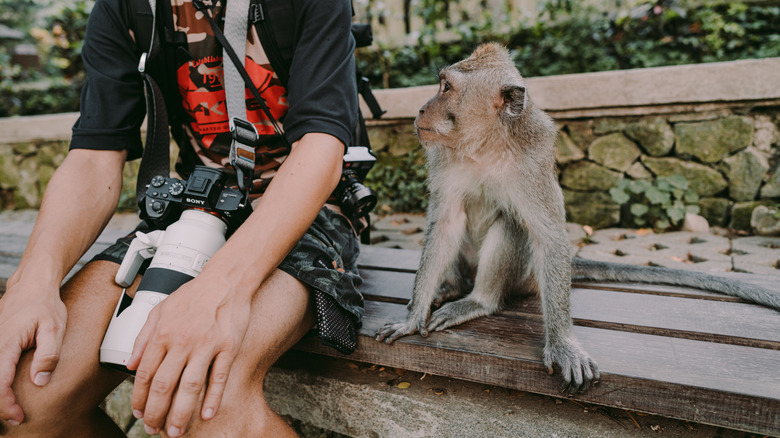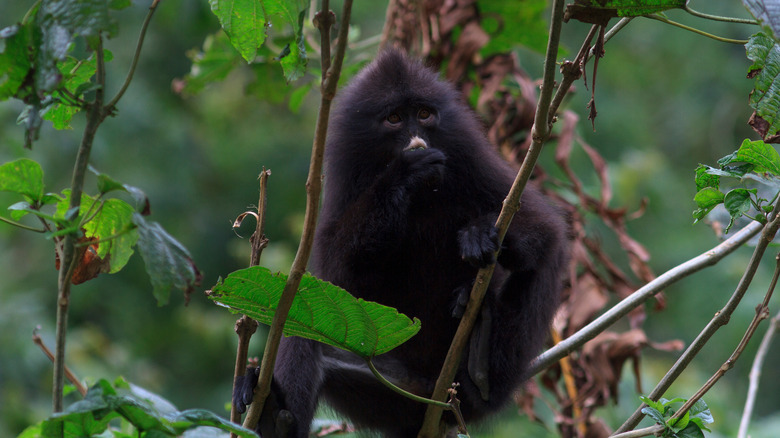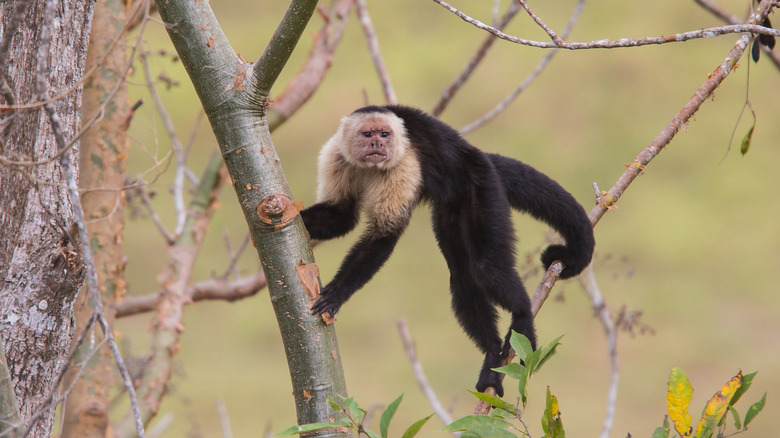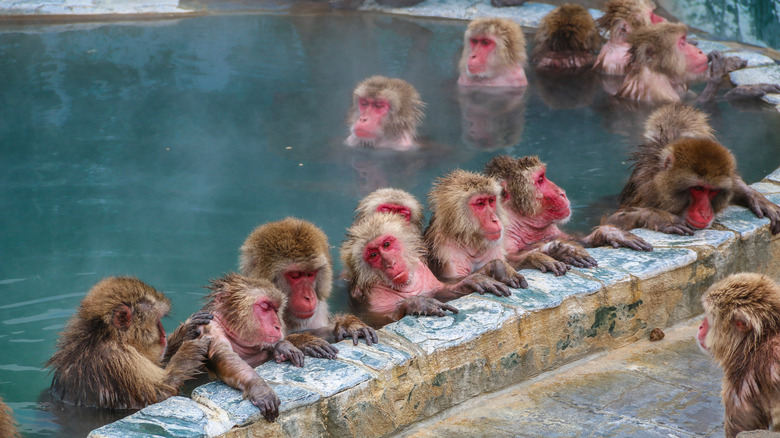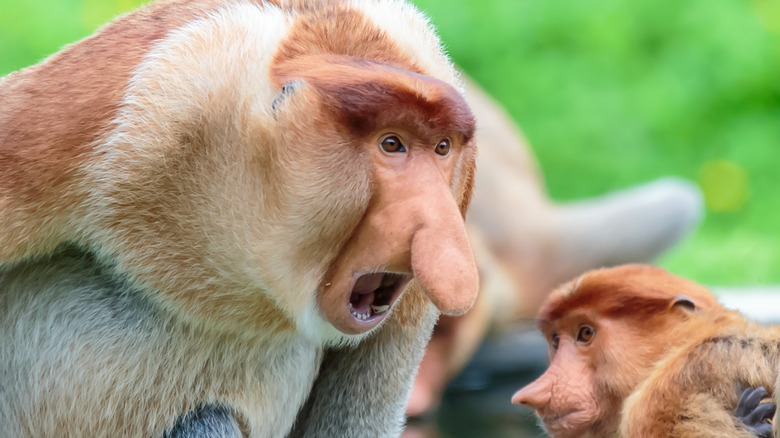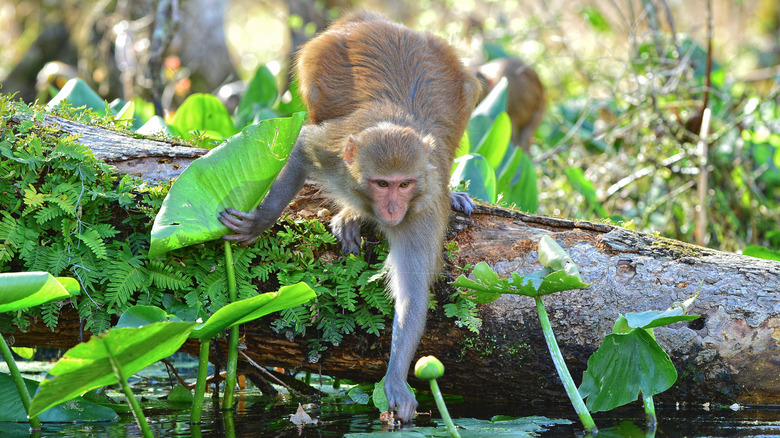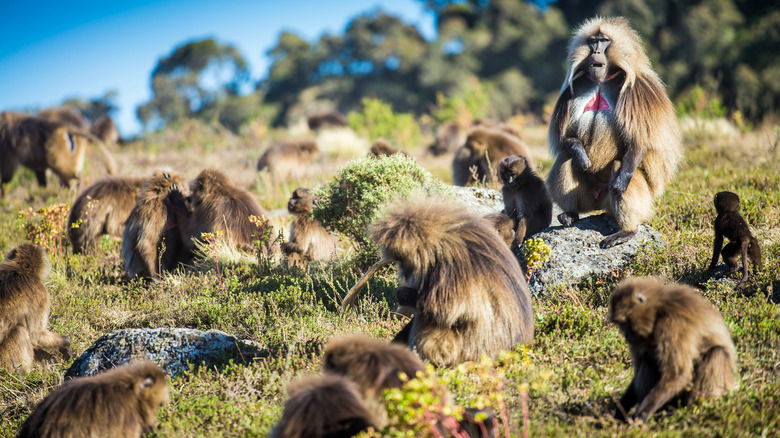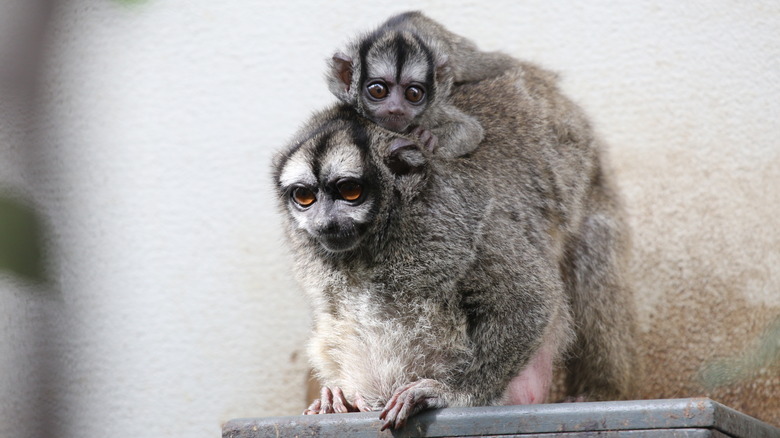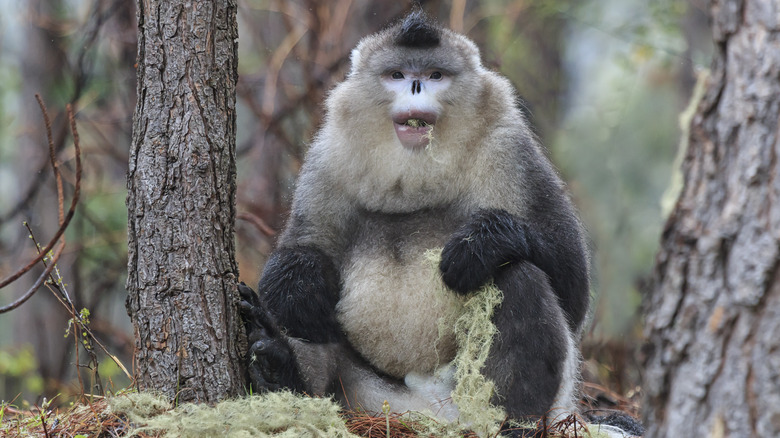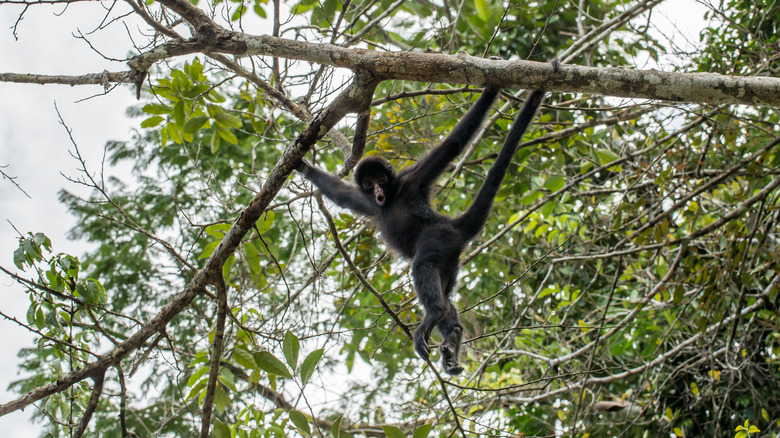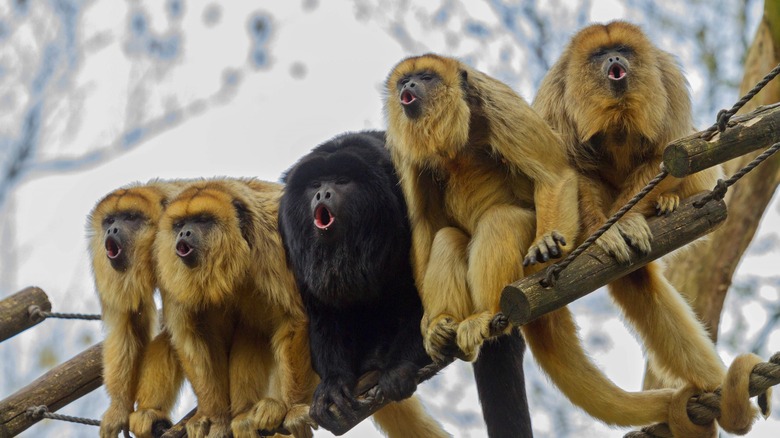14 Types Of Monkeys And How They Differ
Monkeys are the most numerous type of primate in the world. In fact, according to Britannica, there are almost 200 species of monkeys throughout the world.
Monkeys are often confused with apes, but apes and monkeys are distinct groups of primates. How are they different? In almost all cases, monkeys have tails while apes do not. Monkeys are almost always smaller than apes with narrower chests. In addition, while monkeys are indeed intelligent animals, apes are considered more intelligent. Using this definition, chimpanzees, gibbons, orangutans, and gorillas are apes, not monkeys.
Because of their worldwide range, monkeys have diversified into numerous species. Monkeys are divided into two groups: Old World and New World. The first difference is obviously where they live: Old World monkeys include all monkey species in the Eastern Hemisphere while New World monkeys live in the Western Hemisphere. These two groups are also distinguished by certain muscular-skeletal features which create different nasal structures. Plus, many Old World monkeys have opposable thumbs which most New World monkeys do not, and many New World monkeys have prehensile tails which can grab. If you ever see a monkey swinging by its tail from a branch, it is a New World monkey.
So let's quit monkeying around and take a look at 14 notable monkey species which show how, even though they are all monkeys, they are all different.
Mandrills
Mandrills are one of the most distinct species of monkey in the world. As described by National Geographic, they are the largest species of monkey, weighing up to 77 pounds and featuring brightly colored blue and red faces as well as equally bright hindquarters. Curiously, the coloration of the mandrill becomes brighter when it is more excited. While these monkeys feature long canine teeth, they are primarily for self defense. In fact, if you see a mandrill baring its teeth to another mandrill, it is more likely to be a friendly greeting than an act of aggression.
Britannica notes that this species lives primarily on the ground in groups of over 100 within their rainforest homes in Central Africa, and most of their day is spent looking for food such as roots, fruit, lizards, insects, and reptiles. Despite living in such large groups, their total population is unknown because they are very elusive. At one point, mandrills were grouped with baboons, another ground dwelling type of monkey, due to similarities in appearance and behavior. However, scientific analysis has separated them into their own genus. Mandrills have been classified as vulnerable by the International Union for Conservation of Nature (IUCN) due to habitat encroachment and poaching.
Pygmy Marmosets
While mandrills are the largest species of monkey in Africa, the smallest species of monkey is found in the rain forests of South America. The pygmy marmoset, according to the San Diego Zoo, weighs a half an ounce at birth at most. When fully grown, a "large" pygmy marmoset could top the scales at 5 ounces. They are a maximum of 6 inches long in the body, but feature a long tail of up to 9 inches. They are objectively cute.
The University of Michigan's Animal Diversity Web notes that these monkeys have long incisors which have evolved to accommodate their diet of tree sap and gum. Basically, they use their teeth to drill holes into trees and then suck up the sap. They supplement this with insects — grasshoppers are a favorite. Because of their small size, they are an obvious item on the menu for larger predators, so their yellow, green, and brown colorations work well to camouflage them. For their own protection, pygmy marmosets mainly live in the mid-level of the rainforest, above the ground away from land predators, but also not at the top of the canopy where they may fall victim to birds of prey. Currently, pygmy marmosets do not face significant conservation threats.
Long-tailed macaque
The long-tailed, or crab-eating, macaque is a species of monkey found throughout Southeast Asia, both on the mainland and on the surrounding islands. Animal Diversity Web describes these monkeys as being capable of living in a variety of habitats from mangrove swamps to forests. Despite their name, these macaques eat an omnivorous diet ranging from flowers to fruit to insects to, yes, crabs. They are also very adaptable, being able to even expand their range into human areas.
The long-tailed macaque is remarkable, too, for its various interactions with humans over history. One notable contribution is, according to Columbia University, that this species was the primary test subject for the polio vaccine. Another is how, on the island of Bali, they are considered by some to be sacred. However, these same monkeys on Bali also engage in criminality. The Guardian reports that long-tailed macaques inhabit the Uluwatu temple where they regularly steal valuable belongings from tourists, such as mobile phones, cameras and wallets. But if you expect to see these monkeys taking selfies, guess again. They proceed to ransom it back to the tourists in exchange for food, which encourages more bad behavior.
The East Sumatran and Raffles' banded langur
Once upon a time, the banded langur of Southeast Asia was thought by scientists to range from Myanmar to Indonesia. Even though their numbers weren't great, scientists believed that their extensive range would help them avoid imminent extinction. This changed, according to National Geographic, in 2020, when it was discovered that the banded langur was three separate species: the Raffles', Robinson's, and East Sumatran banded langur. Since the species look so much alike — black coloration with very subtle white markings on the front — the mistake was excusable. It was also hard to prove that they were indeed separate species, as banded langurs inhabit the rainforest canopy and flee immediately from humans. It was only after genetic analysis of langur fecal matter that it was concluded that they were separate species.
Of the three new species, the East Sumatran and Raffles' banded langur face the greatest threat, and are critically endangered. According to the New England Primate Conservancy, these species fell victim to human highway construction projects with fragmented its range. They estimate that there are perhaps 60 individual Raffles' banded langurs left.
Capuchin monkeys
Capuchins are one of the world's most recognizable monkey genuses, and perhaps best known to popular culture are the white-faced capuchins, who were used as organ grinder monkeys. The distinctive top of their hair gave them their name, because, according to Britannica, it resembles the caps of Capuchin monks. In the wild, up to five different species of capuchins live in the canopies of the forests of South and Central America feeding on an omnivorous diet of fruit, leaves, insects, eggs, and small animals. Capuchins are also not adverse to raiding nearby farms for produce.
Aside from their ties to popular culture, Capuchins are noted for their opposable thumbs (rare in New World monkeys) as well as large toes which enable them to adroitly handle objects. This perhaps has contributed to their intelligence: Capuchins are considered the smartest of the New World monkeys. National Geographic reports that this species has roughly the same brain-to-body size ratio as chimps, which is a metric often used to measure intelligence. To further support capuchin intelligence, Nature reports that the bearded capuchin does in fact use tools in the form of stones to break open nuts.
Japanese macaques
While monkeys are thought to be tropical animals, some species have adapted to temperate conditions. The northernmost species of monkey according to National Geographic is the Japanese macaque, sometimes called "snow monkeys." This species inhabits three of Japan's main islands as well as some of the smaller islands in the Japanese archipelago. What makes Japanese macaques unique among monkeys are their adaptations. Animal Diversity Web explains that they live in temperate subalpine regions among broadleaf forests both deciduous and evergreen. The climate can be very cold in winter, so this species has evolved a plush coat of hair to keep it warm — after all, this animal does not hibernate. In fact, some troops of this species immerse themselves during the winter in hot thermal springs just to keep warm. The luxuriant waters are so relaxing to this primate that some even fall asleep while in the water. They have, from this behavior, become a tourist attraction in and of themselves.
These monkeys obviously have much appeal. In fact, according to "The Texas Snow Monkeys," a troop of 152 them was transplanted to land near Laredo, Texas in 1972, ostensibly to sell to the research and pharmaceutical industries. The heat, predation, and disease killed half of the troop in the first year. However, they soon adapted and thrived, living off of cactus. Within 20 years, their numbers rose to 600. After the founder of the sanctuary died, the monkeys were rounded up and moved to a sanctuary in San Antonio.
Proboscis monkeys
In the jungles along the rivers of the island of Borneo lives a monkey who sports an epic nose. Or, at least half of proboscis monkeys do, since, as National Geographic reports, only male proboscis monkeys feature such a dominant facial characteristic. Why such a big nose among boy proboscises? The answer is that the species is sexually dimorphic; that is, the different sexes of the same species take on different physical characteristics. The males use the immense nose to attract mates since the appendage apparently enhances calls by promoting echoes. Despite these differences, both male and female proboscis monkeys share one trait: They both have distended guts.
The proboscis monkey also stands out from other monkeys for reasons besides its nose. First, the proboscis is one of the larger monkey species. According to the University of Wisconsin, adult males weigh on average about 44 pounds while females weigh 22. They are also the monkey most adapted to swimming with several of their digits being webbed. These monkeys will leap into the water, cross rivers, and can swim almost 66 feet completely underwater.
Rhesus macaques
Rhesus macaques are native to mainland Asia with a range, according to Animal Diversity Web, from Central to Southeast Asia, and their short head hair makes their facial expressions especially distinct. Rhesus macaques are very adaptable monkeys. National Geographic summarizes how, in areas of India where the monkey is sacred to Hindus, they often cohabitate in human settlements. This is not just in India: In Silver Springs State Park in Florida, hundreds of rhesus monkeys who had escaped captivity from a proposed theme park established a thriving colony. Unfortunately, these monkeys carry a variation of herpes that is deadly to humans. The monkeys do not seem to show much fear of humans, and there have been several negative interactions between them. This has raised health concerns and some calls for the control, if not removal, of the animals. However, there does not seem to be any public appetite to do so in any serious ways; perhaps they are just too cute.
Rhesus monkeys are also the most widely used laboratory monkeys in the United States. Demand for these animals has increased in recent years, according to Nature, due to increased research stemming from the COVID-19 pandemic. However, this has proven to be problematic. While demand for these monkeys as test subjects is high, there is no infrastructure in place to attend to such a number.
Gelada monkeys
With a mane that looks like it was just hot-air-dried and prominent red markings on its chest, the gelada, a baboon-like monkey that inhabits the highland meadows of Ethiopia, stands out among the crowd of other primates. Why? Because this monkey likes to live in huge crowds.
According to National Geographic, Geladas can live in groups of 1,200 individuals. At the base level, these groups are composed of families or harems of one — or a few — dominant males and up to dozen females. Gelada society is very hierarchical, and violent fights often break out between males. It is startling to watch since these monkeys have very long and frightening canines.
Geladas spend most of their life on terra firma dining on grass. They are apparently a remnant of a long tradition of ancient primate grazers that lived in prehistoric times. To support this type of sitting and eating lifestyle, Geladas have evolved fleshy pads on their hindquarters. At night, Smithsonian reports that they typically climb down precipices to escape any hungry predator such as a hyena or leopard.
Owl monkeys
Most people would assume monkeys are diurnal, meaning that they are active during the day. In all cases of monkey species this would be correct, except for one. The owl monkeys, also known as the douroucouli, as reported by Nature, are the only type of monkey that is nocturnal. For this reason, they are called owl monkeys — or also night monkeys. But what about creatures such as bushbabies in Africa? Aren't they nocturnal? Yes, they are, but these are of a different suborder of primates, according to Animal Diversity Web.
The owl monkey genus ranges from Central America to Argentina, and Britannica informs us that there may be as many as nine different species of owl monkeys. Each of these species has unusually large eyes, an adaptation for the nocturnal lifestyle. As described by National Geographic, these monkeys have evolved to have less cone cells (which see color) and more rod cells (which help to see in the dark). They also lack prehensile tails, unlike other New World monkeys.
There has been evolving thought concerning owl monkey behavior. As reported by the Wisconsin National Primate Research Center, these species were once thought to be monogamous. This was based on captive species studies in which pairs did form lifelong monogamous relationships. However, in the wild, owl monkeys family units are more fluid, with outside males replacing existing males through violence.
Black Snub-nosed Monkey
One of the more extremely-adapted monkeys is the black snub-nosed, or Yunnan snub-nosed, monkey of China. According to PBS, this monkey earned its common name from its darkish fur and its nose, which is short and upturned because it lacks nasal bones. This species has the distinction of also living at high elevations in the Yunling mountains of Southwestern China, a region that may have been the inspiration for the legend of Shangri-la. In fact, according to Animal Diversity Web, the black snub-nosed monkey lives at perhaps the highest elevation of any monkey species, ranging to over 13,000 feet above sea level and sometimes higher. Because of this extreme habitat, these monkeys have evolved to digest lichen, which is usually nutrient-poor and toxin-rich for primates. However, to cope with it, this monkey can ferment the matter in its stomach, very similarly to a cow.
Unfortunately, the black snub-nosed monkey is under pressure and is classified as endangered by the IUCN with a population of about 2,500.
Barbary macaque
The Barbary macaque is one of the most well-known monkey species in the world. Tailless and sporting a ginger coat, these monkeys, according to the New England Primate Conservancy, live in Northern Africa — in Morocco and Algeria — thus making them the only macaque to live outside of Asia and north of the Sahara.
Also, the monkey is famed for the population that lives in Gibraltar, the only species of monkey to live in Europe. The population in Gibraltar was first established by the Moors who kept them as pets during the medieval period. However, the original population was wiped out by disease in the 1900s. As a result, the monkeys now in Gibraltar are descendants of a reintroduced population of Barbary macaques from North Africa. Even though the Barbary macaque is highly adaptable just like other macaques, Animal Diversity Web notes that this Gibraltar population is only sustained by the constant reintroduction of new monkeys.
Spider Monkey
Spider monkeys, with their elongated limbs and prehensile tail, are distinctly suited for life in the trees. In the wild, this family of agile monkeys makes its home, according to National Geographic, from South America and as far north as Mexico. These monkeys lack thumbs, but nevertheless are able to maintain a powerful grip on branches. They have often been targeted by human hunters, and as a result, according to Britannica, they are extremely wary of them. Usually at the approach of a human, spider monkeys will bark a warning. Some have even dropped branches on humans in an attempt to frighten them away. Certain species, as reported by the Birmingham Zoo, have been captured to sell as part of the exotic pet trade, but while spider monkeys are cute and watching their acrobatic stunts is as good as any circus, they can also be highly destructive and sometimes aggressive. And they also live for 47 years.
All these factors plus habitat encroachment have pushed spider monkeys onto the growing list of endangered species.
Black howler monkey
At up to 30 pounds, the largest of all New World monkeys are howler monkeys, according to Britannica. The genus is considered truly distinct for how much noise these individual species make. Of the howlers, the black howler monkey of South America is the loudest. In fact, according to the LA Zoo, black howler croaking calls are the loudest animals calls on the planet. Black howler calls can be heard up to 3 miles away and can reach 140 decibels. (150 decibels, incidentally, describes the loudness of a jet engine.) Like other acrobatic New World monkeys, National Geographic notes that howler monkeys have a gripping prehensile tail, which is important since these monkeys rarely leave the trees. Interestingly, males and females sport different-color coats.
Unfortunately, howler monkeys have become endangered due to the usual suspects of human encroachment and illegal hunting. What makes the situation most precarious for them is that these monkeys do not take well to captivity. Their diet and behavior make them difficult to keep and, as a result, conserving their habitat will go much further in preserving these monkeys than breeding programs will.
